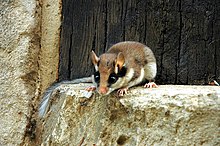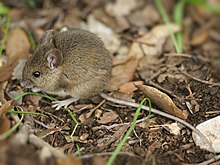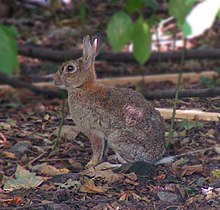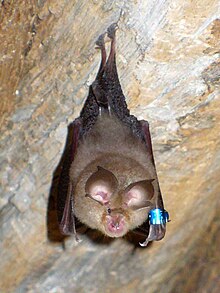List of mammals of the Balearic Islands
All three land mammal species once endemic to the Balearic Islands, Spain (the Majorcan giant dormouse, the Balearic shrew and the goat-like ruminant Myotragus balearicus) are currently extinct,[1] while those presently found on the archipelago have been introduced voluntarily or accidentally by humans in colonization waves beginning in the Neolithic.[2][3]
The following tags are used to highlight each species' conservation status as assessed by the International Union for Conservation of Nature.
| EX | Extinct | No reasonable doubt that the last individual has died. |
| EW | Extinct in the wild | Known only to survive in captivity or as a naturalised population well outside its previous range. |
| CR | Critically endangered | The species is in imminent risk of extinction in the wild. |
| EN | Endangered | The species is facing an extremely high risk of extinction in the wild. |
| VU | Vulnerable | The species is facing a high risk of extinction in the wild. |
| NT | Near threatened | The species does not meet any of the criteria that would categorise it as risking extinction but it is likely to in the future. |
| LC | Least concern | There are no current identifiable risks to the species. |
| DD | Data deficient | There is inadequate information to make an assessment of the risks to this species. |
Order: Rodentia (rodents)[]
Rodents make up the largest order of mammals, with over 40% of mammalian species. They have two incisors in the upper and lower jaw which grow continually and must be kept short by gnawing. Most rodents are small though the capybara can weigh up to 45 kg (99 lb).
- Suborder: Sciuromorpha
- Family: Gliridae (dormice)
- Subfamily: Leithiinae
- Genus: Eliomys
- Garden dormouse, E. quercinus LC
- Genus: Eliomys
- Subfamily: Leithiinae
- Family: Gliridae (dormice)
- Suborder: Myomorpha
- Family: Muridae (mice and rats)
- Subfamily: Murinae
- Genus: Apodemus
- Wood mouse, Apodemus sylvaticus LC
- Genus: Mus
- House mouse, Mus musculus LC
- Algerian mouse, Mus spretus LC
- Genus: Rattus
- Genus: Apodemus
- Subfamily: Murinae
- Family: Muridae (mice and rats)
Order: Lagomorpha (lagomorphs)[]
The lagomorphs comprise two families, Leporidae (hares and rabbits), and Ochotonidae (pikas). Though they can resemble rodents, and were classified as a superfamily in that order until the early 20th century, they have since been considered a separate order. They differ from rodents in a number of physical characteristics, such as having four incisors in the upper jaw rather than two.
- Family: Leporidae (rabbits, hares)
- Genus: Lepus
- Granada hare, Lepus granatensis LC
- Genus: Oryctolagus
- European rabbit, Oryctolagus cuniculus EN introduced
- Genus: Lepus
Order: Erinaceomorpha (hedgehogs and gymnures)[]
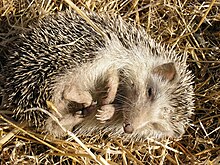
The order Erinaceomorpha contains a single family, Erinaceidae, which comprise the hedgehogs and gymnures. The hedgehogs are easily recognised by their spines while gymnures look more like large rats.
- Family: Erinaceidae (hedgehogs)
- Subfamily: Erinaceinae
- Genus: Atelerix
- North African hedgehog, Atelerix algirus LC
- Genus: Atelerix
- Subfamily: Erinaceinae
Order: Soricomorpha (shrews, moles, and solenodons)[]
The "shrew-forms" are insectivorous mammals. The shrews and solenodons closely resemble mice while the moles are stout bodied burrowers.
- Family: Soricidae (shrews)
- Subfamily: Crocidurinae
- Genus: Crocidura
- North African white-toothed shrew, Crocidura ichnusae DD
- Lesser white-toothed shrew, Crocidura suaveolens LC
- Genus: Crocidura
- Subfamily: Crocidurinae
Order: Chiroptera (bats)[]
The bats' most distinguishing feature is that their forelimbs are developed as wings, making them the only mammals capable of flight. Bat species account for about 20% of all mammals.
- Family: Miniopteridae (long-winged bats)
- Subfamily: Miniopterinae
- Genus: Miniopterus
- Common bent-wing bat, Miniopterus schreibersi NT
- Genus: Miniopterus
- Subfamily: Miniopterinae
- Family: Molossidae (free-tailed bats)
- Subfamily:
- Genus: Tadarida
- European free-tailed bat, Tadarida teniotis LC
- Genus: Tadarida
- Subfamily:
- Family: Rhinolophidae (horseshoe bats)
- Subfamily: Rhinolophinae
- Genus: Rhinolophus
- Greater horseshoe bat, Rhinolophus ferrumequinum NT
- Lesser horseshoe bat, Rhinolophus hipposideros NT
- Mehely's horseshoe bat, Rhinolophus mehelyi VU
- Genus: Rhinolophus
- Subfamily: Rhinolophinae
- Family: Vespertilionidae (mouse-eared bats)
- Subfamily: Myotinae
- Genus: Myotis
- Lesser mouse-eared bat, Myotis blythii NT
- Long-fingered bat, Myotis capaccinii VU
- Geoffroy's bat, Myotis emarginatus LC
- Greater mouse-eared bat, Myotis myotis LC
- Natterer's bat, Myotis nattereri LC
- Genus: Myotis
- Subfamily:
- Genus: Barbastella
- Barbastelle, Barbastella barbastellus NT
- Genus: Eptesicus
- Serotine bat, Eptesicus serotinus LC
- Genus: Hypsugo
- Savi's pipistrelle, Hypsugo savii LC
- Genus: Plecotus
- Grey long-eared bat, Plecotus austriacus LC
- Genus: Pipistrellus
- Kuhl's pipistrelle, Pipistrellus kuhlii LC
- Common pipistrelle, Pipistrellus pipistrellus LC
- Soprano pipistrelle, Pipistrellus pygmaeus LC
- Genus: Barbastella
- Subfamily: Myotinae
Order: Cetacea (whales)[]

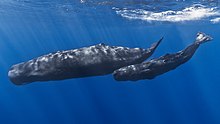
The order Cetacea includes whales, dolphins and porpoises. They are the mammals most fully adapted to aquatic life with a spindle-shaped nearly hairless body, protected by a thick layer of blubber, and forelimbs and tail modified to provide propulsion underwater.
- Suborder: Mysticeti
- Family: Balaenopteridae (rorquals)
- Genus: Balaenoptera
- Fin whale, Balaenoptera physalus VU
- Genus: Balaenoptera
- Family: Balaenopteridae (rorquals)
- Suborder: Odontoceti
- Family: Delphinidae (dolphins and pilot whales)
- Genus: Delphinus
- Short-beaked common dolphin, Delphinus delphis EN
- Genus: Globicephala
- Long-finned pilot whale, Globicephala melas DD
- Genus: Grampus
- Risso's dolphin, Grampus griseus DD
- Genus: Orcinus
- Orca, Orcinus orca DD
- Genus: Pseudorca
- False killer whale, Pseudorca crassidens NA
- Genus: Stenella
- Striped dolphin, Stenella coeruleoalba VU
- Genus: Tursiops
- Common bottlenose dolphin, Tursiops truncatus VU
- Genus: Delphinus
- Family: Physeteridae (sperm whales)
- Genus: Physeter
- Sperm whale, Physeter macrocephalus EN
- Genus: Physeter
- Family: Ziphiidae (beaked whales)
- Genus: Ziphius
- Cuvier's beaked whale, Ziphius cavirostris VU
- Genus: Ziphius
- Family: Delphinidae (dolphins and pilot whales)
Order: Carnivora (carnivorans)[]
There are over 260 species of carnivorans, the majority of which feed primarily on meat. They have a characteristic skull shape and dentition.
- Family: Viverridae (civets and mongooses)
- Genus: Genetta
- Common genet, G. genetta LC introduced
- Genus: Genetta
- Family: Viverridae (civets and mongooses)
- Suborder: Caniformia
- Family: Mustelidae (weasels)
- Genus: Martes
- European pine marten, M. martes LC introduced
- Genus: Mustela
- Least weasel, M. nivalis LC introduced
- Genus: Martes
- Family: Phocidae (earless seals)
- Genus: Monachus
- Mediterranean monk seal, M. monachus EN possibly extirpated
- Genus: Monachus
- Family: Mustelidae (weasels)
Order: Artiodactyla (even-toed ungulates)[]

The even-toed ungulates are ungulates whose weight is borne about equally by the third and fourth toes, rather than mostly or entirely by the third as in perissodactyls. There are about 220 artiodactyl species, including many that are of great economic importance to humans.
- Family: Bovidae (cattle, antelope, sheep, goats)
- Subfamily: Caprinae
- Genus: Capra
- Balearean boc, C. capra var. majorcan introduced
- Genus: Capra
- Subfamily: Caprinae
Notes[]
- ^ Bover, Pere; Alcover, Josep A.; Michaux, Jacques J.; Hautier, Lionel; Hutterer, Rainer (2010). Goswami, Anjali. ed. "Body Shape and Life Style of the Extinct Balearic Dormouse Hypnomys (Rodentia, Gliridae): New Evidence from the Study of Associated Skeletons". PLoS ONE 5 (12): e15817. doi:10.1371/journal.pone.0015817. PMC 3013122. PMID 21209820.
- ^ Alcover, Josep Antoni (1980) "Note on the origin of the present mammalian fauna from the Balearic and Pityusic Islands". Misc. Zool., 6: 141-149
- ^ The taxonomy and naming of the individual species is based on those used in existing Wikipedia articles as of 9 January 2013 and supplemented by the common names and taxonomy from the IUCN where no Wikipedia article was available.
References[]
- "Atlas y Libro Rojo de los mamíferos terrestres de España". Gobierno de España - Ministerio de Agricultura, Alimentación y Medio Ambiente. 2012. Retrieved 2 Jan 2013.
- Aulagnier, S. et al. (2008) Guide des mammifères d'Europe, d'Afrique du Nord et de Moyen-Orient. Delachaux et Niestlé, Paris
- Purroy, F.J. and Varela, J.M. (2003) Guía de los Mamíferos de España. Península, Baleares y Canarias. Lynx Edicions, Barcelona.
See also[]
- Fauna of the Balearic Islands
- Balearic Islands-related lists
- Lists of biota of Spain
- Lists of mammals
- Mammals of Europe
